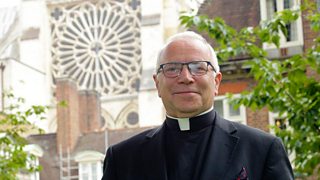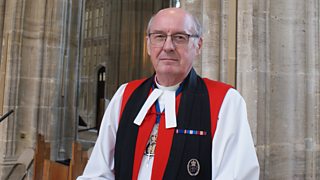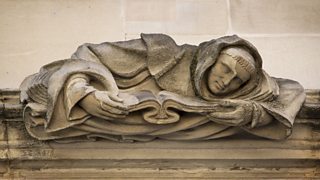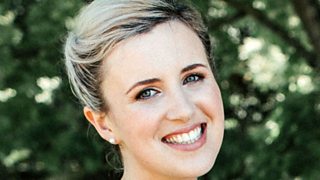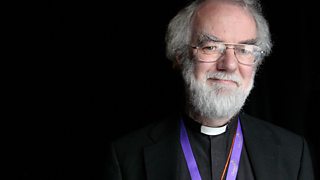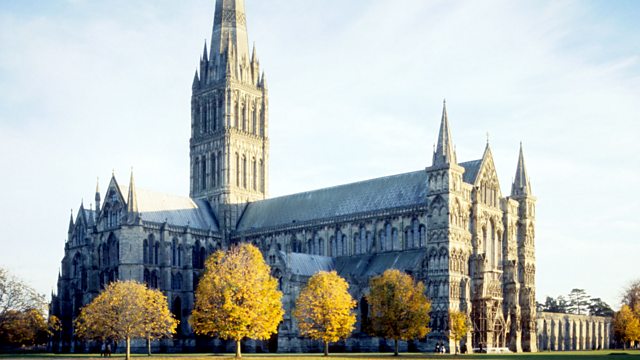
Unless the Lord builds the house...
The Bishop of Salisbury Nicholas Holtam marks the 800th anniversary of Salisbury Cathedral
The Bishop of Salisbury Nicholas Holtam marks the 800th anniversary of Salisbury Cathedral and its move from Old Sarum. The original Salisbury Cathedral was completed at Old Sarum in 1092 under Osmund, the first Bishop of Salisbury. In 1220 the foundations were laid for this Cathedral on the 'New Sarum' site and within 38 years the main body of the building was completed. Bishop Nicholas and the Cathedral's Canon Precentor, the Revd Anna Macham, reflect on what this very special building means for the people of God in the city and diocese, and the vision, faith and human ingenuity that not only saw this building raised, but eight centuries on ensure it remains open, if only virtually.
Producer: Andrew Earis
Last on
More episodes
Previous
Script
This script cannot exactly reflect the transmission, as it was prepared before the service was broadcast.��It may include editorial notes prepared by the producer, and minor spelling and other errors that were corrected before the radio broadcast.It may contain gaps to be filled in at the time so that prayers may reflect the needs of the world, and changes may also be made at the last minute for timing reasons, or to reflect current events.
Poem: How the ancient church of Salisbury was moved and a new one built
Word by Henry d'Avranches, d. 1260 (translated by Francis Young)
read by Simon Russell Beale
Anna Macham
Good Morning.�� I’m standing in my garden, looking up at the towering spire of Salisbury Cathedral.��Those beautiful words were written by Henry of Avranches, a poet in the court of King Henry III, in around 1225.����I can well imagine him lingering here in the Cathedral Close, soaking up the sounds and smells of nature around him, as he watched the new Cathedral being built.����This has been a very special week for us here in Salisbury, marking 800 years since the laying of the foundation stones.����The Cathedral was then completed in only 38 years, an amazing achievement.�� In our service this morning, we tell the story of the move from Old Sarum,��the site of the original Cathedral two miles north of here, and the bold decision to construct a new one in the verdant pastures below.����I’m joined by the Dean and the Bishop of Salisbury, and together we reflect on the meaning of this iconic building that has brought comfort and inspiration to so many in its long-��and sometimes turbulent- history.��
Hymn: Glorious things of thee are spoken
Salisbury Cathedral Choir, directed by David Halls. Organist John Challenger
CD: Great Hymns from Salisbury (Priory Records)
Almighty God, to whose glory we celebrate with joy the laying of the foundation stones of this new cathedral 800 years ago, we praise you for the many blessings you have given to those who worship you here: and we pray that all who seek you in this place may find you, and, being filled with the Holy Spirit, may become a living temple acceptable to you;through Jesus Christ our Lord, Amen.
This has been another difficult week, as we adjust to new ways of living and working.����We could never have imagined that we wouldn’t be able to celebrate the 800th anniversary in the building as planned.��Instead, all the participants today are speaking from their own private houses, mainly in the Cathedral close, and with the silent presence of the Gothic stones towering over us.����But, as I’ve been putting together online acts of worship to mark it this week, the story of Old Sarum and the vision that inspired the Bishop, Dean and Canons to move the Cathedral has given me comfort.�� ��Then, as now, there were many barriers that prevented the whole community from meeting and praying together.����The obstacles the community faced were of a very different kind, but it didn’t stop them from fulfilling their vision, as the Dean, Nicholas Papadopulos, explains.����
Dean of Salisbury
“In the same way the faithful who wish to visit the mother church on Ash Wednesday and Maundy Thursday…are refused entry, the guards giving as an excuse that some danger threatens the defences”.��So wrote Pope�� Honorius to Richard Poore, Bishop of Salisbury, in 1218, setting out his reasons for allowing the move from the windy hilltop of Old Sarum to the spacious plain beneath.��The old cathedral was built in the shadow of the king’s castle. Nothing that the clergy did escaped his soldiers’ notice. As the Pope noted, that was an inconvenience to worship.��But it was also a danger to life. A few years earlier the blood of Archbishop Thomas Becket had been spilt on the stones of Canterbury Cathedral by knights who believed they were doing the king’s will.��Close proximity to royal power was a deadly risk. As the community descended the hill they brought with them their treasures. On one of these the ink was barely dry.��It was a copy of Magna Carta, the most potent symbol of liberty that human beings have ever written.��In its historic move the cathedral community put itself beyond the reach of arbitrary power, and took with it a copy of the nation’s first corporate attempt to rein in arbitrary such power.��The community’s move was a bid to ensure, enhance, and extend human liberty. Worshipping the One who proclaims liberty for captives, Salisbury Cathedral remains faithful to that vocation.
Hymn: Be thou my vision
Salisbury Cathedral Choir, directed by David Halls. Organist John Challenger
CD: Great Hymns from Salisbury (Priory Records)
Prayer God of freedom and of justice,��we pray for our world and its needs, especially in these challenging times.We give thanks for the witness of those who stand firm for their beliefs and principles in the face of tyrannous regimes.����We rejoice in the principles of Magna Carta, and we pray for the leaders of the nations and all who struggle for peace, justice and reconciliation in our world.�� Amen.
Anna Macham
The people longed to dwell in the holy habitation, the place of glory.�� After many years of darkness, oppression and struggle, and fears over how they would fund their project,��the vision of creativity and ingenuity they the community dreamed of would soon be brought to reality.����
Dean of Salisbury
“As your church is situated on a considerable eminence it is continually buffeted by the winds, so that you can scarcely hear each other speak while you are celebrating the divine offices,��and the place is so damp that those who live there are subject to constant illnesses”.��Pope Honorius also included those disobliging words about the site of the old cathedral in his letter to Bishop Richard Poore. Up at Old Sarum the cathedral was exposed to the ravages of the English weather;it had no water supply; it was cramped and confined. But below it, where five rivers met, was what we might today call a greenfield site.��Here, a new cathedral and a new city could be built, and the Bishop’s community set about the deliberate cultivation of their new environment.��There would be a sacred enclosure: the Close. There would be a commercial equivalent: the market square. Streets and squares for traders and artisans would be marked out:��Salisbury’s famous chequers. New water meadows would control flooding and offer irrigation. And at the heart of it all the new Cathedral would rise,��completed in just thirty-eight years, the work of one generation. Stone, glass, timber, lead: every inch of the construction draws the gaze upwards, heavenwards.��The work has never stopped. In the masons’ yard and in the song school, in the glaziers’ workshop and on computer screens, remarkable gifts are still being exercised.��Salisbury Cathedral exists to nurture, celebrate, and inspire the gifts that we all have, the gifts of human creativity.��
Music: And I saw a new heaven - Edgar Bainton
Salisbury Cathedral Choir, directed by David Halls
CD: Best Loved Anthems from Salisbury (Priory)
Prayer
God of beauty,��we give thanks for those whose faith and skill, artistry and labour built this�� holy place, for the love, care and commitment of generations of craftsmen and women.We pray that this house of prayer may continue to be a workshop of the Spirit, and a witness to your creative presence in the world. Amen.
Reading: 1 Peter 2: 4-7
Anna Macham
We heard from Henry of Avranches at the beginning.�� Another poet connected with Salisbury, George Herbert, in the seventeenth century,��and frequent visitor to the Close, regularly attended Evensong in the Cathedral, which was his “heaven on earth,” according to an early biographer, Izaak Walton.����A lute player and highly musical poet, and lover of nature, it’s no surprise that his poems are a popular choice with composers.�� In this poignant setting of “The Flower,”��by Alec Roth, the poet compares the seasons of the soul, and the movement from times of desolation to consolation, to flowers coming up from the earth after the barrenness of winter.
Anthem: The Flower -��Alec Roth
Salisbury Cathedral Choir, directed by David Halls
CD: Poetry in Music: Musical settings of the words of George Herbert (Priory)
Anna Macham
In a few moments’ time our preacher is will be the Bishop of Salisbury, Nicholas Holtam. But first we hear words from the Gospel According to Luke, Chapter 4.
Reading: Luke 4.16-21
Sermon: Bishop of Salisbury
Being locked out of our cathedrals and church buildings makes a strange context in which to mark the 800th anniversary of the foundation of the “new” Cathedral here in Salisbury.����It is one of the most beautiful and recognisable buildings in Europe with the highest spire in England earthing heaven set in the largest and loveliest Cathedral Close with water meadows beyond.
Church buildings are closed but church continues. We’re praying at home, holding worship online, organising care for neighbours especially the most vulnerable.��Church is people, as the reading from 1 Peter said ‘living stones’, as well as buildings. But it’s not one or the other: church is both. People and buildings are intimately connected across time.��Our churches, what Simon Jenkins calls “the museums of England”, carry people’s stories and history.��
February seems a long time ago but at the start of what was to be a series of events marking the 800th anniversary there was a light show projecting the history onto the building inside and out.��Night after night the place was packed with people come to look at the stones like they were crying out from a building populated by thousands more people than we could see across time.
Look at and around Salisbury cathedral – as you can do in the virtual tour online - and you can see in it the sweep of 800 years of history.��The adaptability of Christianity to speak of God in time, is one of the reasons Christianity is a great missionary religion.��
For centuries this English Gothic building with its medieval Sarum Rite influenced the Church across Europe.
You can see in the stones the impact of the Reformation and of repeated re-orderings that changed people’s experience of being the people before God in this place.��I love the thought of George Herbert, 17th century country parson, priest and poet, walking across the meadows to Evensong: “Teach me my God and king in all things thee to see.”��
Towards the end of the 1700s the building was closed for two periods of two and three years for refurbishment and renewal, much longer than now.
In 1816 John Constable began a series of visits to what was then a very fashionable renewed Salisbury.�� The paintings he produced are now among the nation’s favourites.����One in 1826 from the garden of what was the Bishop’s Palace has the small figures of the bishop, his wife and ahead of them their soon to be married daughter.����The bishop is pointing something out on the great cathedral with his stick.�� An art historian commented that the bishop is the master of all he surveys, but the building doesn’t work like that.����It’s bigger than any of us.����The bishop in his day might seem quite a big figure but I’m the 78th Bishop of Salisbury and the bishop at any one time has a small part in an enterprise that spans time and points to eternity.
Philip Larkin memorably wrote in a poem called Church Going,��A serious house on serious earth it is.What is much less well remembered are the opening lines,��Once I am sure there is nothing going on��I step inside, letting the door thud shut.��Well, now the doors are shut and the people outside, but the building is still working for us; “a thin place”, “where prayer has been valid.”����These are not just the museums of England.�� They are places where we find ourselves in relation to God and one another and all creation.
In 1831, Constable made another of those great paintings of Salisbury cathedral from the meadows.��The very dark clouds above the cathedral reflect Constable’s own grief after his wife’s death, as well as the difficulties England was facing of poverty and of political reform.��So the storms Constable was depicting had some parallel ingredients to the grief we are experiencing now with this wretched virus after years of austerity and the (political) divisiveness of BrexitTheir uncertainty and anxiety must have been much as we feel now with this wretched virus after years of austerity and Brexit.����The spire soars into the sky and light breaks through the storm clouds as sunshine falls on the west front of the cathedral.����Later Constable added a rainbow, a popular addition that instantly made the painting a winner.��The rainbow was not in support of the NHS but a sign of hope when the Biblical flood is past: God’s covenant with all creation.��In troubled times the cathedral is a symbol of hope. That’s why we feel so acutely our not being able to go into it.
Nowadays a visit to Salisbury cathedral is interpreted by three contemporary artistic commissions.��We enter the Christian life and the Church by the font, through baptism. Here in Salisbury, we go past William Pye’s large font at the west end of the cathedral,��its huge volume of water wonderfully still and reflective, overflowing, the water of life abundant.
Beyond the font, the large space is for prayer, contemplation and worship. At the east end to which we are pointed is a window by Gabriel Loire.��It’s very dark blue and populated by people hard to see, figures from the Passion of Christ and prisoners of conscience today.����From bottom left to top right it’s as if a door has been opened giving light to people in darkness.��Like Jesus reading from the prophet Isaiah in the synagogue in Nazareth that we heard today, there’s a vision of God’s kingdom in which the sick are healed, the blind given sight and the oppressed go free.��Christianity is for worship and what we do as a consequence is the test of it.��
So the third contemporary artistic commission that interprets the building for us today is outside the cathedral that is dedicated to the Blessed Virgin Mary.��Elizabeth Frink’s Walking Madonna, walking away from her cathedral into the city.��It’s what happens at the end of every service when the people are dismissed to go out and get on with the work of God in the world God made and loves.��It is in that interplay of Church and world where we find what it is to love God and neighbour. What happens in church is an inestimable resource for our daily lives.
Like people in exile, we long to return home. We will get back into our churches and we will be different,��changed by the inner journeys we’ve made and the simpler everyday faith at home we’ve been experiencing.����And when we are back in our buildings how much more we will value their sacred space that contains our joys and sorrows and points creatively beyond itself to the�� revealing and healing truth, love, justice, and peace of God that makes us fully human.����May the Lord bless our going in and coming out for ever more. Amen.
Anthem: Behold the tabernacle - WIlliam Harris
Salisbury Cathedral Choir, directed by David Halls
CD: Best Loved Anthems from Salisbury (Priory)
Prayers
Gracious God, we offer our praise and thanksgiving for the witness of this Salisbury’s Cathedral Church for 800 years.����We praise you for the inspiration, solace and prayerful space it has offered to those who have come here as congregation, pilgrims and visitors.����We give thanks for its ongoing witness in times of trouble and of peace.�� And we pray that all who see it today may be uplifted by its grandeur and glimpse your glory,��who are the source of all beauty and truth.
Eternal God, we give thanks for the unbroken thread of worship in this place, stretching back to the Cathedral at Old Sarum for close to a thousand years.��We pray for all the churches of this City and Diocese, for our ecumenical relationships here and beyond, for our links with the church in South Sudan and Sudan.����We give thanks for successive Deans and Chapters, for Cathedral musicians, and for the community of faith that has gathered day by day in worship and prayer,��in the sharing of a common life.�� We pray that the architecture of this building may have its counterpart in lives set on fire by your love and committed to sharing the vision of your glory.
God of compassion, keep us under the shadow of your mercy in this time of uncertainty and distress.�� Sustain and support all who are anxious or fearful, and lift up all who are brought low.����Be close to those who are ill or in pain, and those who surround and care for them.�� In this time of trauma, give us strength and comfort, as we pray with confidence as our Saviour has taught us:��Our Father, who art in heaven..
Hymn: O Jesus I have promised
Salisbury Cathedral Choir, directed by David Halls. Organist John Challenger
CD: Great Hymns from Salisbury (Priory Records)
Blessing: Bishop of Salisbury
Christ, whose glory is in the heavens,fill this house and illuminate your hearts;and the blessing of God almighty,the Father, the Son, and the Holy Spirit,be among you and remain with you always. Amen.
Organ Voluntary - Marche Heroique - Herbert Brewer
played by Daniel Cook on the organ of Salisbury Cathedral
CD: The complete organ works of Sir Herbert Brewer (Priory)
��
Broadcast
- Sun 3 May 2020 08:10�鶹Լ�� Radio 4


